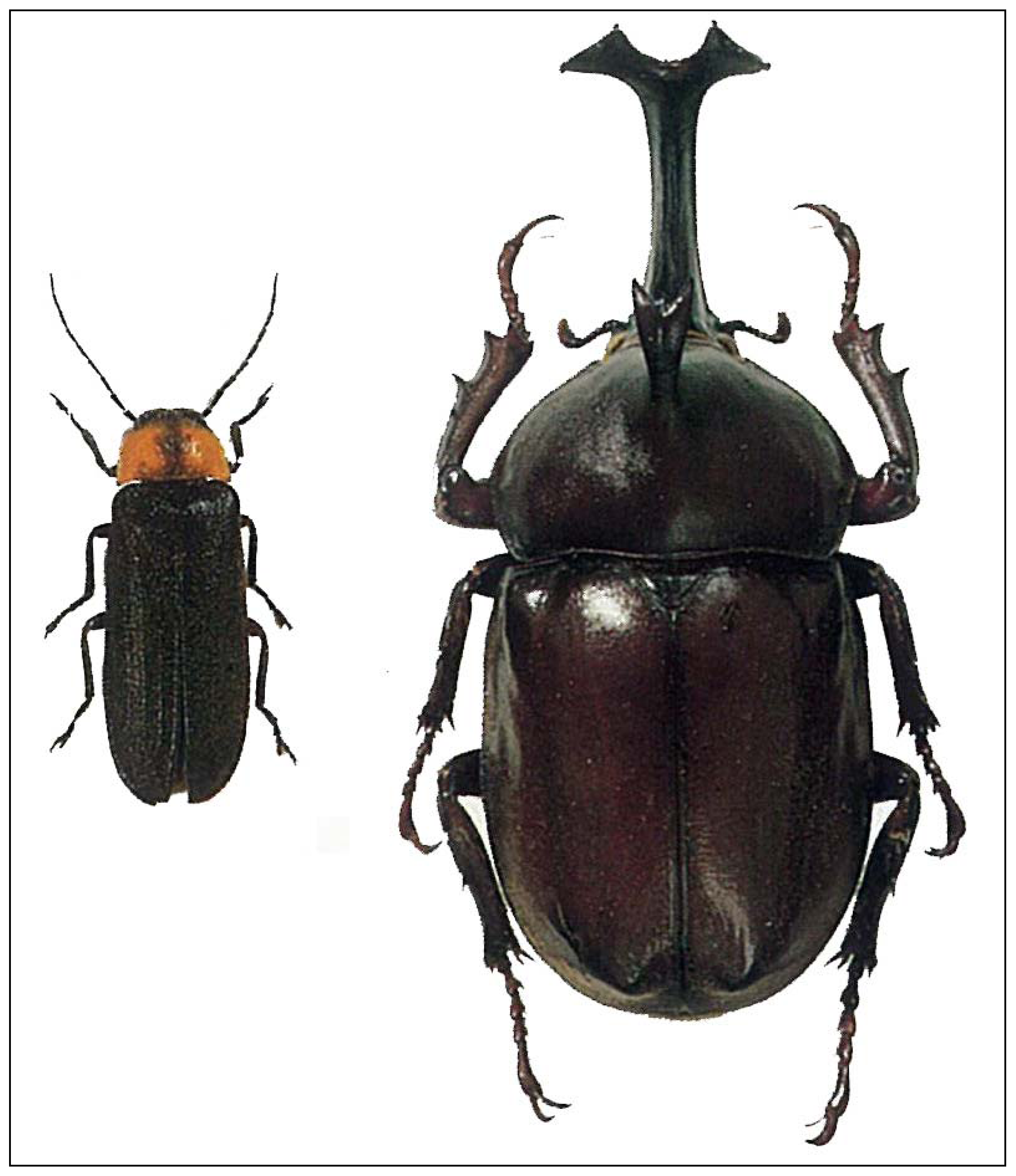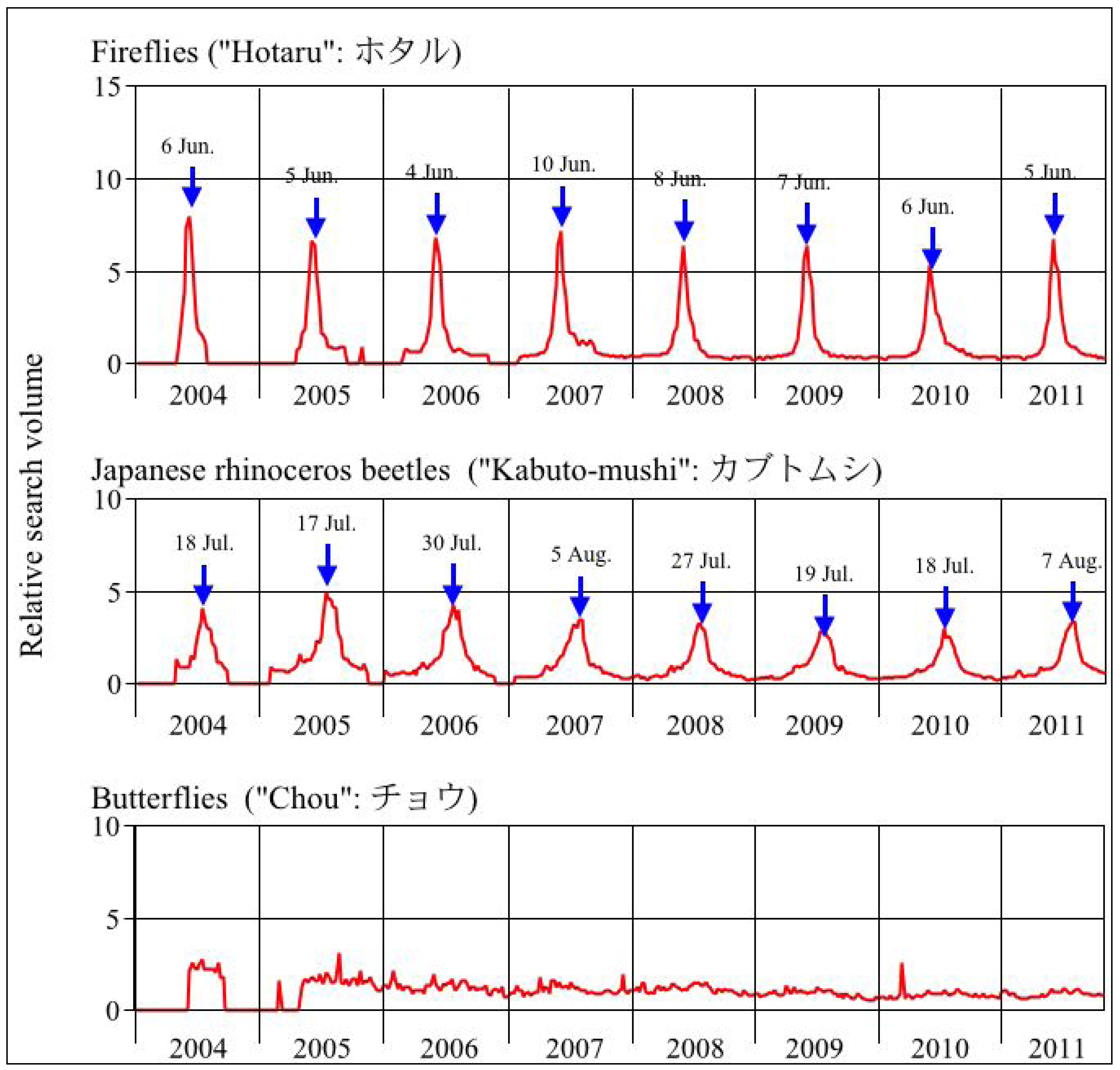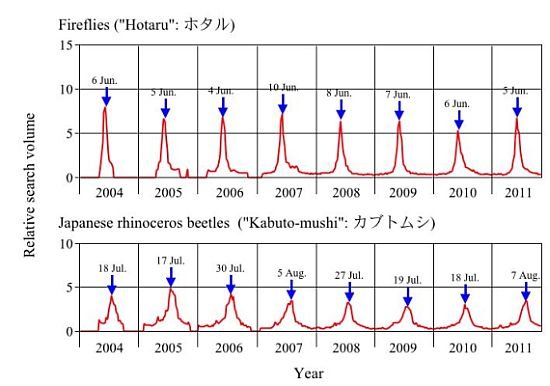Japanese Interest in “Hotaru” (Fireflies) and “Kabuto-Mushi” (Japanese Rhinoceros Beetles) Corresponds with Seasonality in Visible Abundance
Abstract
:1. Introduction
2. Experimental Section
2.1. Materials

2.2. Method
| English | Japanese reading | Japanese writing(Katakana scripts) |
| firefly | Hotaru | ホタル |
| Japanese rhinoceros beetle | Kabuto-mushi | カブトムシ |
3. Results and Discussion

4. Conclusions
Acknowledgments
References and Notes
- Hogue, C.L. Cultural entomology. Annu. Rev. Entomol. 1987, 2, 181–199. [Google Scholar] [CrossRef]
- Mitsuhashi, J. Cultural entomology. The Heredity 2000, 54, 14–15. [Google Scholar]
- Takada, K. Insect associated with human being—Note on culturally important insects and their influence on human societies (Cultural entomology). Tokkuribachi 2009, 77, 9–20. [Google Scholar]
- Takada, K. Popularity of different coleopteran groups assessed by Google search volume in Japanese culture—Extraordinary attention of the Japanese to “Hotaru” (lampyrids) and “Kabuto-mushi” (dinastines) (Cultural entomology). Elytra 2010, 38, 299–306. [Google Scholar]
- Takada, K. Cultural coleopterology: An outline of cultural entomology of coleopteran insects. Coleopterist’s News 2010, 170, 13–18. [Google Scholar]
- Meyer-Rochow, V.B.; Nonaka, K.; Boulidam, S. More feared than revered: Insects and their impact on human societies (with some specific data on the importance of entomophagy in a Laotian setting). Entomologie heute 2008, 20, 3–25. [Google Scholar]
- Dunn, R.R. Poetic entomology: Insects in Japanese haiku. Am. Entomol. 2000, 46, 70–72. [Google Scholar]
- Konishi, M. Insects, Man and Books; Soshinsha: Osaka, Japan, 2007; p. 519. [Google Scholar]
- Okui, K. A note on the expression to be concerned with insect. Kiyo (J. Kitasato Univ. Kyoyoubu) 1992, 26, 137–157. [Google Scholar]
- Meyer-Rochow, V.B.; Okui, K.; Henshall, K.; Brook, D.L. The mental concept of worm/bug in Japanese and English idioms. J. Finnish Anthropologicak Soc. 2000, 25, 29–40. [Google Scholar]
- My Voice Communications, Inc. Insects (result of voluntary planning attitudinal survey). MyVoice. 2008. Available online: http://www.myvoice.co.jp/biz/surveys/11009/index.html (accessed on 30 December 2011).
- Takada, K. Beetle and human culture—A mini review of cultural entomology of scarabaeid beetles. Coleopterist’s News 2010, 172, 27–31. [Google Scholar]
- Takada, K. Beetle in our culture—A mini review of cultural entomology of lampyrid beetles. Sayabane New Series 2011, 2, 25–31. [Google Scholar]
- Laurent, E.L. Mushi. BNET. 2001. Available online: http://findarticles.com/p/articles/mi_m1134/is_2_110/ai_71317743/ (accessed on 3 April 2011).
- Yuma, M. Change in attitudes towards nature represented in haiku. In How to Japanese See Dragonflies; Ueda, T., Ed.; Kyoto University Press: Kyoto, Japan, 2004; pp. 377–407. (in Japanese) [Google Scholar]
- Takada, K. Commentary on the “Beetle Queen Conquers Tokyo (Kabuto Tokyo in Japanese)”, A Movie Exploring the Mystery of the Japanese Fascination with Insects, from the Aspect of Cultural Entomology. Elytra, Tokyo, New Series 2012, 2. in press.. [Google Scholar]
- Battelle, J. The Search; Pengium Group: New York, NY, USA, 2005; p. 336. [Google Scholar]
- Rangaswamy, A.; Giles, C.L.; Seres, S. A strategic perspective on search engines: thought candies for practitioners and researchers. J. Interact. Market. 2009, 23, 49–60. [Google Scholar] [CrossRef]
- Goel, S.; Hofman, J.M.; Lahaie, S.; Pennock, D.M.; Watts, D.J. Predicting consumer behavior with Web search. PNAS 2010, 107, 17486–17490. [Google Scholar]
- Takada, K. Popularity of different lampyrid species in Japanese culture as measured by Google search volume. Insects 2011, 2, 336–342. [Google Scholar] [CrossRef]
- Sato, M. Lampyridae. In The Coleoptera of Japan in Color Vol. III; Kurosawa, Y., Hisamatsu, S., Sasaji, H., Eds.; Hoikusha: Tokyo, Japan, 1985; pp. 121–124. (in Japanese) [Google Scholar]
- Kurosawa, Y.; Kobayashi, H.; Masumoto, K.; Ochi, T. Scarabaeidae. In The Coleoptera of Japan in Color Vol. II; Ueno, S., Kurosawa, Y., Sato, M., Eds.; Hoikusha: Tokyo, Japan, 1985; pp. 348–419. [Google Scholar]
- Cabinet Office of Japan. Monthly Consumer Confidence Survey (March 2011). Available online: http://www.e-stat.go.jp/SG1/estat/GL08020101.do?_toGL08020101_ (accessed on 30 February 2012).
- Ohba, M. Mystery of Fireflies; Doubutsu-sha: Tokyo, Japan, 2009; p. 307. (in Japanese) [Google Scholar]
- Waldbauer, G. Fireflies, Honey, and Silk; University of California Press: Berkeley, CA, USA, 2009; p. 233. [Google Scholar]
- Kajita, H.; Aoyama, I. Firefles, Humans and Culture; Daigaku Kyoiku Shuppan: Okayama, Japan, 2010; p. 140. (in Japanese) [Google Scholar]
- Takeda, M.; Amano, T.; Katoh, K.; Higuchi, H. The habitat requirement of the Genji-firefly Luciola cruciata (Coleoptera: Lampyridae), a representative endemic species of Japanese rural landscapes. Biodivers. Conserv. 2006, 15, 191–203. [Google Scholar] [CrossRef]
- Kobori, H.; Primack, R.B. Conservation for Satoyama, the Traditional Landscape of Japan. Arnoldia 2003, 62, 3–10. [Google Scholar]
© 2012 by the authors; licensee MDPI, Basel, Switzerland. This article is an open access article distributed under the terms and conditions of the Creative Commons Attribution license (http://creativecommons.org/licenses/by/3.0/).
Share and Cite
Takada, K. Japanese Interest in “Hotaru” (Fireflies) and “Kabuto-Mushi” (Japanese Rhinoceros Beetles) Corresponds with Seasonality in Visible Abundance. Insects 2012, 3, 424-431. https://doi.org/10.3390/insects3020424
Takada K. Japanese Interest in “Hotaru” (Fireflies) and “Kabuto-Mushi” (Japanese Rhinoceros Beetles) Corresponds with Seasonality in Visible Abundance. Insects. 2012; 3(2):424-431. https://doi.org/10.3390/insects3020424
Chicago/Turabian StyleTakada, Kenta. 2012. "Japanese Interest in “Hotaru” (Fireflies) and “Kabuto-Mushi” (Japanese Rhinoceros Beetles) Corresponds with Seasonality in Visible Abundance" Insects 3, no. 2: 424-431. https://doi.org/10.3390/insects3020424





